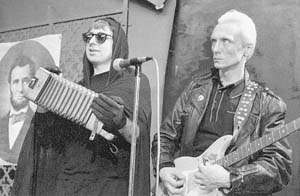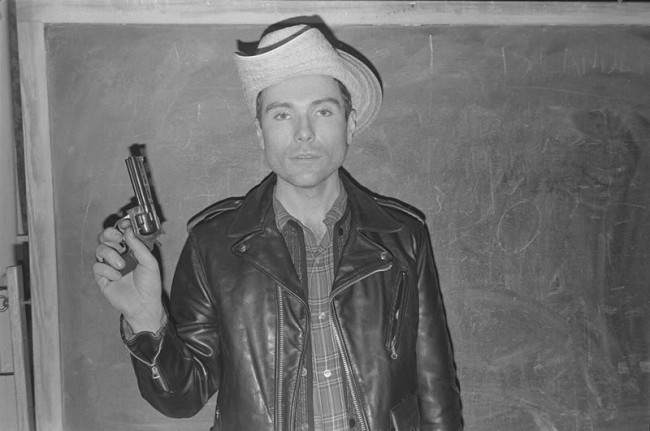Glenn O’Brien’s New York TV show TV Party ran from 1978 to 1982. Before we get to the episode where Blondie’s Debbie Harry taught the cool kids how to pogo like the British punks, Glenn explains what it was and why it happened:
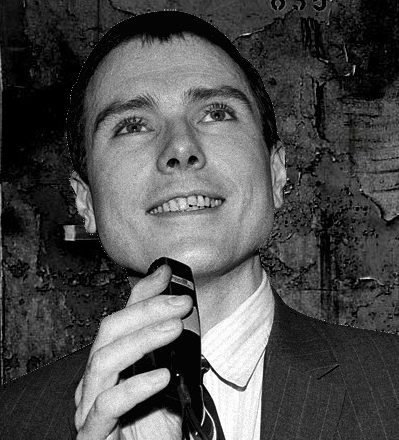
Glenn O’Brien writes:
In 1978, I was writing a column called Glenn O’Brien’s BEAT for Andy Warhol’s Interview Magazine. I was also contributing to High Times, art magazines and foreign music magazines. I had no ambition to write for the square press, I had already been through Rolling Stone and Esquire and Playboy and I was trying to do something more artistic.
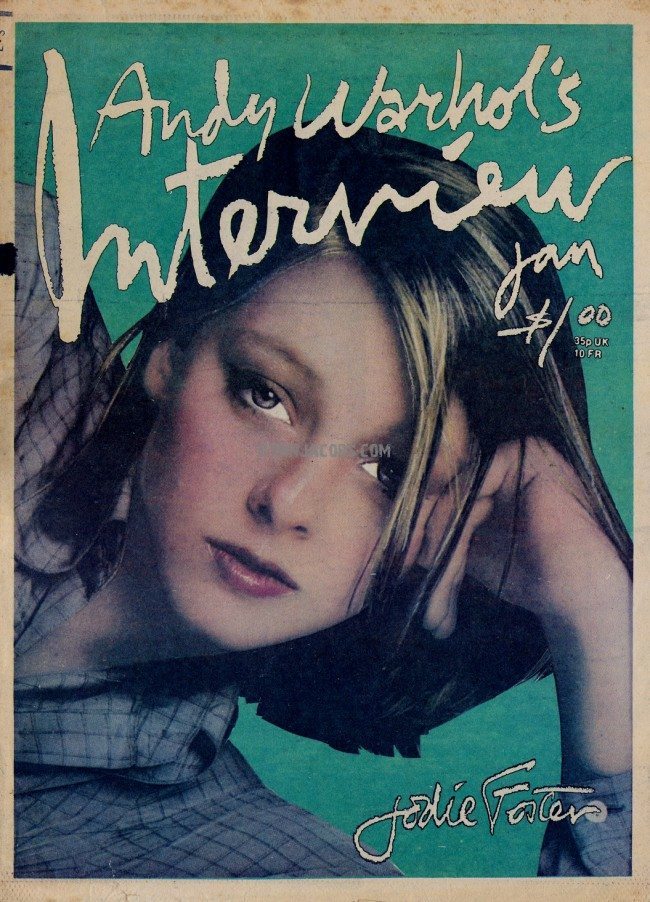
It wasn’t hard to make a living as a freelance writer then. My apartment on St. Mark’s Place cost $100 a month, and I was able to pay my rent by selling unwanted review albums to St. Mark’s Records. I had a white Toyota Corolla, with out of state plates and no insurance. Every night I drove around town, hitting all the clubs. I got in and drank for free. The Mudd Club was my living room. Danceteria was my rec room. I was the Damon Runyan/Walter Winchell/Ed Sullivan of the new wave scene.
Ed Sullivan was the benchmark. As Steve Dollar notes::
As the host of The Live! Show on Manhattan Cable Television’s Channel J, Mr. Davidovich appeared in the guise of ‘Dr. Videovich’, presiding over a Vaudevillian enterprise “that was like a combination of Ernie Kovacs meeting Cabaret Voltaire,” he said. “I was the Ed Sullivan of the avant-garde.” It was 1979, and Manhattan public access television was hitting its eccentric stride.
O’Brien would end up fronting his show on Manhattan Cable. But before that he had to learn the ropes:
One day in ’78 I ran into Coca Crystal, a woman I knew from High Times who hosted a public access cable show called “If I Can’t Dance You Can Keep Your Revolution” (after an Emma Goldman quote.) Coca’s show featured Yipees and bohemian characters, like Tuli Kupferberg of the Fugs. They smoked pot on air and talked about anarchy. Coca asked me to come on her show and I said sure.
Coca’s show was fun but I didn’t think anything about it until the next day. I was on the subway and strangers came up to me and said “Hey, I saw you on TV last night.” Others accosted me on the street. I thought, “My God, people are watching this stuff!” Public Access programming had been going for a few years. It was a part of New York City’s agreement with the cable companies. In exchange for their monopolies the city’s two cable companies had to provide the public with access to programming. In other words, they had to let amateurs have television shows. Amazingly, with no money, you could have a show with a potentially huge audience of Manhattan cable subscribers.
I went over to Manhattan Cable and signed up for a time slot. You could pre-record your show or you could do it live from E.T.C. studios, like Coca did. That’s what I wanted to do. Live television. That’s the way TV was when I was a kid. It was exciting. Anything could happen. I remember watching Playhouse 90 and the U.S. Steel Hour in the fifties and a set might fall over, or someone would blow a line badly or a stagehand would accidentally walk in front of the camera with a ladder. I saw prizefighter Benny “Kid” Paret killed in the ring live on TV on April 3, 1962 when I was fifteen years old and Lee Harvey Oswald shot and killed live on TV on November 24th, 1963. I knew live was where it’s at.
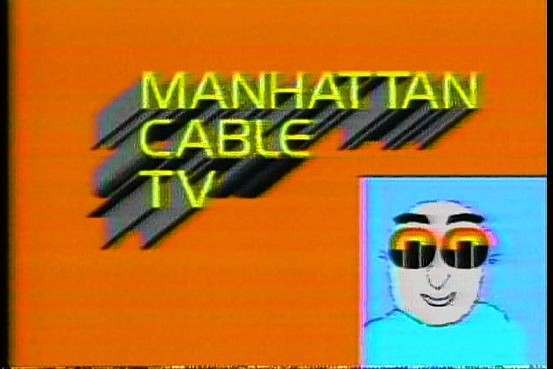
E.T.C. Studios [Experimental Television Center] was run by an interesting fellow named Jim Chladek. Jim was a school teachery kind of guy: idealistic, nerdy, controlling, and easily annoyed but basically a humanist who was remarkably tolerant, considering the weirdoes who used his facilities. He reminded me of Mister Rogers and he treated us like children. For about $60 one could use his black and white studio for an hour and broadcast live. To make a tape of it ran you another $20 or so. The studio had three cameras, one of them usually out of focus, and numerous microphones, at least half of which were broken. It would have been difficult for real technicians to produce a visible, audible show here, and we weren’t technicians.
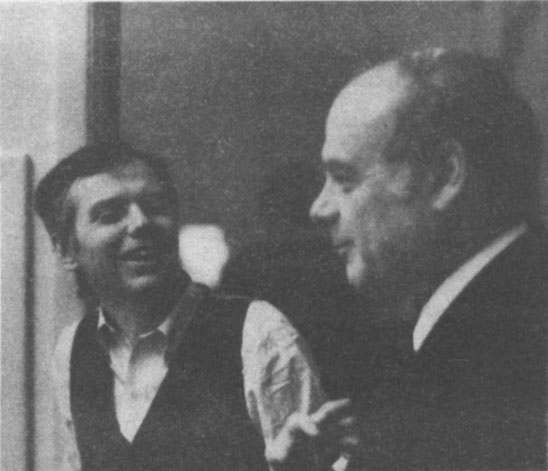
Michael McClard (left) and Jim Chladek of ETC (Experimental Television Center) studios where 90 percent of public access programming originates. Via Bomb Mag
It didn’t matter. My first real job in New York was working for Andy Warhol. He was my mentor. I was a great fan of his movies and I liked the “bad” camerawork. Somehow the lack of technical slickness heightened the realism and impact of the films. So as long as TV Party looked and sounded as good as Andy’s “Nude Restaurant,” I was happy.
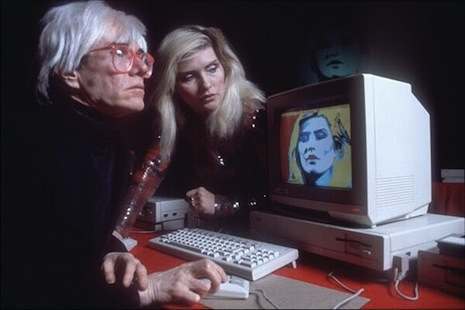
Warhol paints Debbie Harry on an Amiga Commodore computer in 1985
The TV Party gang came together spontaneously. My best friends were Chris Stein, the guitarist of Blondie, Edo Bertoglio, a photographer, with whom I collaborated on many magazine jobs (and later on the film Downtown 81,) and the film director Amos Poe. Edo became a cameraman. Amos became the director. Chris became the show’s co-host. Chris and I had a lot of things in common: friends, music, art, drugs and delinquency. We were serious pot heads and we were always trading buds and talking big ideas. Blondie was on the rise. They had recorded the album “Parallel Lines” over the summer of ’78, and were starting to hit it big. That album eventually sold more than 20 million copies. The year 1979 saw their first number one hit “Heart of Glass.”
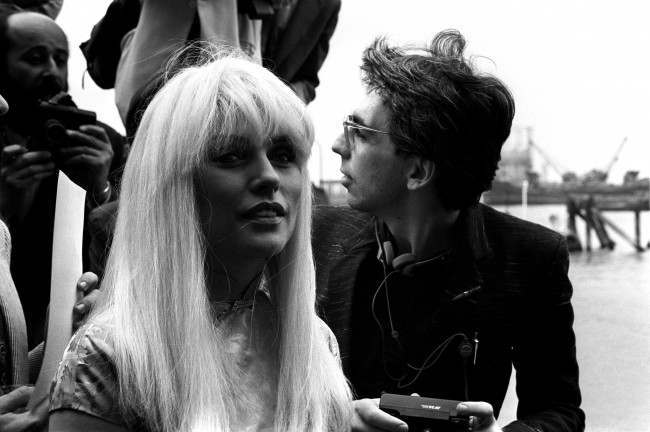
Blondie singer Debbie Harry with her husband, guitarist Chris Stein
Date: 01/05/1982
There was a lot more to Chris than one saw on stage with Blondie. He was (and is) a total wacky genius, brimming with ideas. When he wasn’t working on Blondie he was producing acts like Walter Steding, Gun Club, James White and the Blacks, Tav Falco and Panther Burns, and Iggy Pop. Chris saw TV Party as a perfect forum, and like me, he thought we could use it to take over show biz. Chris was the resident expert on cable TV. His idea of a good time was laying in bed smoking giant reefers and watching “Tele-Psychic” on Channel D.
He saw the possibilities that existed outside the straightjacket of the networks. We were just a little early and a little out there. But TV Party was a great forum for Chris’s expansive mind, droll personality and extra dry wit. I think it helped him vent a lot of the frustrations he had with management and big record companies. If I was Johnny Carson, Chris was Ed McMahon, although we were a lot hipper than Johnny and Ed.
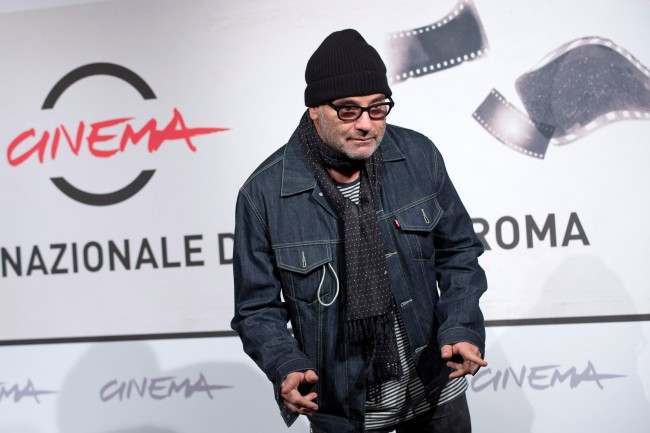
Director Amos Poe poses during the photo call of the movie “A Walk in the Park”, presented at the Rome Film Festival, in Rome, Friday, Nov. 9, 2012.
Amos Poe had made such films as “Blank Generation,” “Unmade Beds,” and “The Foreigner.” We shared a certain sensibility (e.g. a love of Godard, pot and borscht belt humor) and so Amos just became the regular director of the show. From his seat in the control room he talked to the camera operators and told them what to do. He told them to shoot our feet, or the person who wasn’t talking. Then he would push the control panel buttons, switching cameras in time with the music, or go nuts on the fader, putting images on top of one another. Sometimes it looked more like a light show from the Fillmore than a TV show.
Here’s Debbie Harry in Unmade Beds:
After every show I would yell at Amos. “What were you thinking?” Then we would have a drink and forget about it. A lovely guy named Chris Randall, who seemed to just show up one night out of nowhere, became our regular soundman. I don’t know what became him but he did a heroic job considering the abysmal technical conditions of the studio, and although he wasn’t from our crowd, somehow he understood our twisted sensibilities.
There was a rotating pool of camera people, including Edo, my then girlfriend Barbara Egan, Kirsten Bates, Lisa Rosen, Fab Five Freddy, Maripol, Betsy Sussler, Diego Cortez and Johanna Heer. When Amos couldn’t make it Betsy, Kirsten or Barbara filled in as director. Debbie Harry directed one show, Kate Simon another. People would protest “I don’t know how!” and I’d say, “Good!” It was all unplanned, basically. Each week we had two or three minutes to get in the studio after the previous show and get going. Sometimes we had a theme. Usually we just winged it.
We followed some wacky shows on the Manhattan Cable lineup including John Wallowitch, a show tunes maven who played campy piano bar favorites and The Robin Byrd Show, a porno talk show which was one of the best things that ever happened to us. We inherited a large audience from Robin. I suspect many of our viewers had lingering erections, which might explain some of the phone calls we received.
Fab Five Freddy was a student at Medgar Evers College when he called me up and told me he was a fan. He wanted to meet me. I wasn’t too sure about this, but finally I decided to meet him. He was very smart and knowledgeable and ambitious. He was so ambitious I suspected him briefly when my Rolodex disappeared. Fred trained on TV Party. He went from being a self-conscious cameraman, (his first on camera moments remind me of stammering, tongue-tied Ralph Kramden going on TV on the “Honeymooners”) to the slick emcee of the shiny hip-hop world which was the light at the end of the next tunnel.
Sometimes Chris went on the road with Blondie and he would call in from Singapore or Vegas, or he would send us remote video segments, usually Debbie baffling unsuspecting citizens of far away places. Debbie too was a loyal member of the TV Party gang, but as Chris’s girlfriend and roommate she was always reserved about her role. It was Chris’s show. In Blondie she got all the attention, so I think that she liked being a little behind the scenes on TV Party. She was often in the control room with Amos, distracting him from his job.
Glenn O’Brien could sing his way through a roll-call of some of the more notable participants in the original TV Party.
Our Doc Severinsen was Walter “Doc” Steding. Walter was a violinist who played the downtown clubs as a one-man band, opening for groups like Blondie, Suicide and the Dead Boys. I met him through his job at the Warhol Factory. Walter was Andy’s painting assistant and general handyman. Everyone else at the Factory dressed in chic jackets and ties. Walter wore an industrial gray Dickies work shirt with a gas station type name patch on it-Walter-and matching gray workpants and hat. He looked like a janitor. And he sort of was. He was the one guy at the Factory who could do the physical jobs, plus stretch canvas and work with Andy as a painting assistant.
Andy loved Walter like a son, an annoying son. Walter was very cute, polite, well mannered, capable and talented, both as a visual artist and as a musician. He had a lot in common with Andy. They were both from lower middle class immigrant families that lived outside Pittsburg. They were both extraordinary draftsmen. And they were both incredibly indirect, coy, perverse, passive aggressive and cryptic. I think theirs was a true love/hate relationship.
Andy admired Walter enough to become his manager, his first venture of that sort since the Velvet Underground. Andy produced Walter’s music videos and did his record covers and gave him support, but he was constantly vexed by Walter and he fired him periodically for being difficult. (He would rehire him promptly.) I think Andy was annoyed by Walter’s peasant stubbornness, which mirrored his own.
I knew immediately that I wanted Walter to be the leader of the TV Party Orchestra. He had an encyclopedic wealth of obscure knowledge and a delightfully unpredictable spontaneity. Walter brought in the other regular orchestra member, Lenny Ferrari. Lenny was a great drummer, but an even greater personality–a truly funny guy who could perform “bad” magic as the entertainer “Luigi Ciccolini” or come up with a genius costume on 24 hours notice. Because ETC Studios didn’t allow real drums, Lenny invented the TV Party drum kit, which consisted of a music stand, small cymbals and the New Yorker Magazine.
Other TV Party orchestra members were less permanent. Sometimes members of Walter’s band, The Dragon People, joined in, like the beautiful bassist Katherine Ruby. Tim Wright was pretty regular on the show, with or without the band. The genius bassist of DNA, Tim could take a toothbrush or a typewriter and turn it into a virtuoso instrument. He was also part of the TV Party brain trust. Tim was one of my closest pals and he had a magical way of thinking. He was the shaman of the show. Another regular guest was John Lurie, the sax playing leader of the Lounge Lizards who was also an underground film star and downtown heart throb. John would come on the show and played a beautiful solo and then leave shaking his head. We were never sure if he was insulted, horrified or had to go somewhere.
John Lurie – via Issue Mag
Later TV Party shows feature the great Robert Aaron, now the musical director of Wyclef Jean’s band. Robert was my friend and next door neighbor. He could play any instrument, from guitar, piano and sax to shakuhachi, pocket trumpet and oboe. He came out of salsa and Haitian music, hooked up with Blondie and Chic and has since played with everyone from Paul Simon to the WuTang Clan. Robert would amuse us by breaking into Haitian patois with taxi drivers and Wolof with street vendors.
I met Robert Fripp interviewing him for Interview and he wound up a TV Party regular. One of our best shows was a phone-in jam, where you could call up and sing with the TV Party Orchestra featuring Fripp. He took the abstract psychedelic jam style of the band to another level. In talk segments Robert lent decorum, politesse and dignity to the proceedings that made them seem even more absurd.
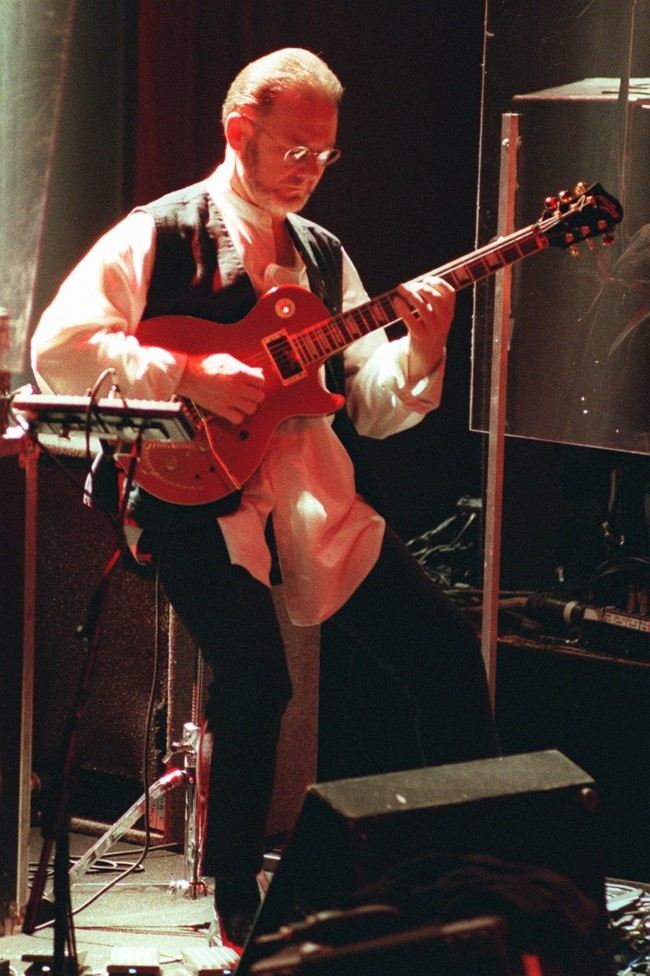
Robert Fripp, of the band King Crimson.
Date: 12/06/1996
Richard Sohl was a great friend. In real life, the keyboard player of the Patti Smith Group, on TV Party he was our Telephone Operator (inspired by Lily Tomlin’s Ernestine,) as well as our unofficial fashion editor. With his sharp wit, a quality underutilized in his role with Patti, Richard loved to answer the phone and was hilarious. He was also always the prettiest girl on the Halloween Show. Richard brought in friends like supermodel Teri Toye, who became a semi-regular, and photographer Steven Meisel.
Lisa Rosen was a fashion model and general star of the scene. She was young but her exploits were already part of the lower Manhattan oral history. Lisa became one of the regular camera operators, but she also something like an assistant guest host because she felt free to ask questions or crack wise from behind the camera. Her favorite lines were “How big is it.” Or “How late was she?” Or “How high was he?”
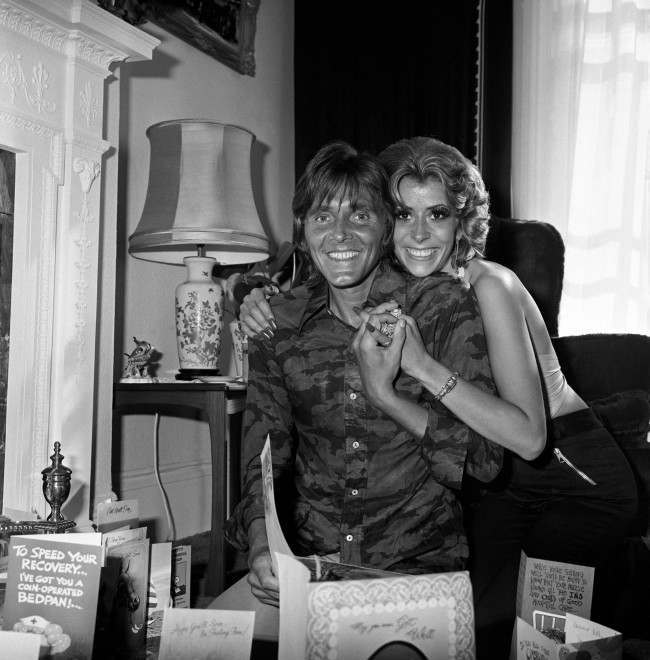
Pop singer Billy Fury with girlfriend Lisa Rosen at home recovering from heart surgery.
Date: 12/07/1976
Kate Simon was a great photographer and a spirited adventurer who often collaborated with me on projects. Kate was good behind the camera and great in front of it, and she always brought interesting people to the show. She had lived in London and knew the scene there, so she became the TV Party British ambassador, hooking us up with people like the Clash.
We had numerous artist guests, like Chris Burden, John Feckner and Peter Fend, who was a semi-regular. Peter Fend is a brilliant geopolitical theorist and one of the most long-winded humans on the planet. I enjoyed torturing viewers by letting Peter ramble on way beyond the tolerance of anyone. The audience was always eye rolling and moaning before I told the band to take it away and gave Peter “the hook.”
I met Jean-Michel Basquiat when I was writing an article on graffiti. I loved the SAMO© graffiti that was all over downtown and when I met him, I loved him too. He was absolutely great—soulful, brilliant, funny, rebellious. I immediately invited him on to TV Party. He came on that week and never left. Sometimes he got in front of the cameras, sometimes he ran a camera, but he really loved running the character generator in the control room. On the shows that have writing running across the screen, that’s him improvising poetry on top of the live action. On the night of the Heavy Metal show Jim Chladek had just gotten a pristine piece of seamless paper for a backdrop and Jean-Michel wrote on it in magic marker: “MOCK PENIS ENVY.” Chladek was horrified and we had to pay for the seamless. I wish I had kept it. God knows how much it would be worth today. It didn’t surprise me when Jean-Michel made it to the top of the art world. I expected it. Aside from posters for his band Gray, I think his only “commercial art” was the posters and credits he did for TV Party. He always did a poster for our nightclub shows. Cheap.
Sometimes, to pay the studio costs, we would do shows in clubs and get the proceeds from the door. We did a few shows at Hurrah, in color with broadcast quality equipment. A fellow named Peter Frank whose family was in the garbage business was going to help us take the show big time. The shows looked great but there was some disagreement. I can’t even remember what it was about, but pretty soon were back to the studio in black and white. We did a disastrous show at the Peppermint Lounge. Who knew that people wouldn’t come out to a club for “Savage Easter?” We did “TV Dinner Party” at Mickey Ruskin’s hipster hangout One University with guests like David Byrne and Robbie Coltrane but the sound was even worse than in the studio. We did a “Psychedelic Show” at Danceteria. It was pretty spectacular, even more disorienting than usual being in living color. It was so disorienting that we seem to have lost the tapes.
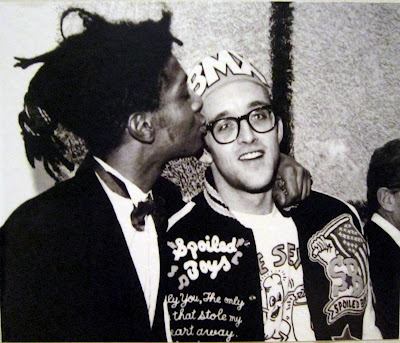
Keith Haring and Basquiat at Dencerteria. Via
We did several very successful shows at the Mudd Club, which was whereyou could find most of the TV Party gang after the show. My pal Steve Mass owned the club and he let us earn some money to pay for our TV studio habit. If you look closely at the Mudd Club show where Debbie sings “The Tide Is High” for the first time you can see a teenage Vinnie Gallo in the front row of the audience. The Heavy Metal Show at Mudd, which is missing, was probably the most spectacular of them all. We had at least a dozen guitarists on stage, playing heavy rock, plus Charles Rocket and his Marshall amped feedback accordion. That show was done before Glenn Branca organized his guitar symphony with a similar instrumentation at the Mudd Club. I think we played the longest version of “Smoke On the Water” in history, and our take on “Whole Lotta Love” was absolutely lethal.

New cast members of NBC-TVÂs remodeled “Saturday Night Live” frolic on the roof of the RCA Building at New York’s Rockefeller Center, Oct. 23, 1980. The six cast members were chosen to succeed the program’s “Not Ready For Prime Time Players,” most of whom have gone on to other acting endeavors. From left to right are: Gail Matthius, Charles Rocket, Denny Dillon, Ann Risley, Joe Piscopo, and Gilbert Gottfried.
Charles Rocket was a latter day regular on TV Party. He was a member of the cast of Saturday Night Live on NBC and he became friendly with Chris and Debbie when Blondie did the show. When Rocket was thrown off the show for saying “fuck” live on national television, TV Party took him in, at a 100% pay cut.
David Walter McDermott was a regular guest. I had met David several years before TV Party, when I was living on the Upper West Side. He and his friends who called themselves “The Salon D’Art Society” made a great show of living in the nineteenth century. They went without phones and electricity and wore wing collars. David was brilliant. His demonstration of the historical changes in singing technique, and his “homosexual minute” are among my favorite highlights. Not long after his TV Party appearances David became a star of the New Wave Vaudeville at Irving Plaza, and not long after that he embarked on a very successful career in painting and photography with his partner Peter McGough. It is unfortunate that he hasn’t made more television appearances, perhaps because electricity is involved.
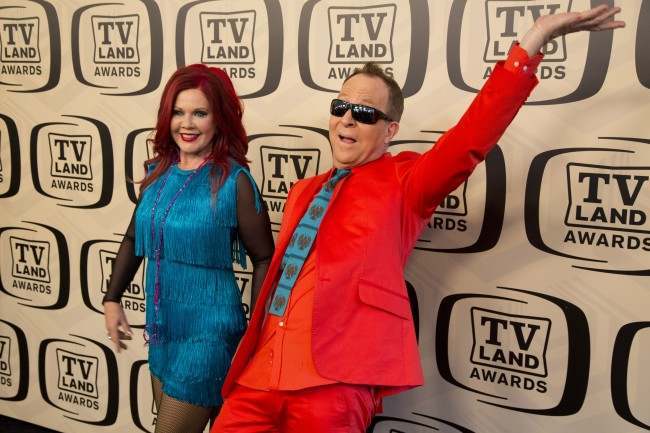
Members of The B-52’s Kate Pierson and Fred Schneider arrive to the TV Land Awards 10th Anniversary in New York, Saturday, April 14, 2012.
Fred Schneider of the B-52s was one of our most frequent guests. Fred could always be counted on for a wretched joke or a freeze-dried bon mot. He always seemed simultaneously cool and flustered. Another member of the TV Party gang was Bobby Grossman. Bobby was the official photographer, the unofficial jester and taster. He was always sitting on the floor snapping pictures of the show, and he rarely missed one. Bobby had a great comic quality. He didn’t say much; he was sort of our Harpo. We were never quite sure if there
was film in Bobby’s camera, but it turned out there was.TV Party wasn’t based on the Johnny Carson type talk show as much as it was based on Hugh Hefner’s shows. Hef’s Playboy’s Penthouse premiered in 1960 and Playboy After Dark appeared in 1969. The format of both shows was a sophisticated cocktail party, not a desk and sofa set up. It was a fantasy of being at a super-hip, super exclusive jet set party. Hef wore a tux and there were always vixens aplenty on set as well as groovy guests like Sara Vaughan, Ella Fitzgerald and Lenny Bruce.
I loved the concept, compared to the stiff format of the Tonight Show. TV Party was Playboy Penthouse twenty years later and with no money. But TV Party was meant to be much more than a regular old talk show. It was meant to be art and it was also meant to be a political party. That’s why you see all of those pictures of Lenin and Engels and Marx and Stalin and Mao hanging on the walls. We were doing “socialist realist TV.”
“TV Party is the show that’s a cocktail party but which could also be a political party.” That was the slogan. My idea was that socialism meant going out every night, and that social action started with socializing. I think we were trying to inject a sort of tribal element into things. That’s what happens when you smoke reefers and read Marshall McLuhan. I was also reading a lot of Ezra Pound and Wyndham Lewis, not to mention Milton Berle and Henny Youngman. I thought we could do subliminal politics as absurdist comedy. I actually did believe in anarchy, as the peaceful society that comes after “the withering away of the state.” I thought withering away the state sounded like fun, so we made fun of the state every chance we got.
I actually intended to get the TV Party on the ballot and run for mayor of New York. I figured that once people got in a voting booth and saw TV Party there they would definitely vote for us. Some people like Democrat and some people like Republican, but everybody loves TV. We went so far as to actually get petition forms. We just never got any signatures. We were sleeping too late. I remember thinking, “If I’m every going to make any money I’m going to have to start getting up before the bank closes.” TV Party was very popular. We were just too much too soon.
We could gauge roughly how many people were watching on a given night when we took telephone calls at the end of the hour. Sometimes the phones would light up as fast as we could hang up, and sometimes we could hang up pretty fast. We were never quite sure who was watching the show, but I was surprised to learn that David Letterman and his producer Robert Morton were. On a couple of occasions Letterman mentioned the show on the air, once saying to Paul Schaeffer “TV Party is the greatest TV show anywhere, ever.” What I didn’t realize until years later was just how popular TV Party was with Manhattan’s high school kids. I don’t know why, what with all the loud music, pot smoking and rudeness.
I guess it was punk TV. We were anti-technique, anti-format, anti-establishment, and anti-anti-establishment. We liked to break all the rules of good broadcasting. Sometimes we would sit around and say, “Well, what should we do now?” Sometimes we sat there and did nothing. They say “dead air” is the kiss of death in broadcasting, but we liked it. Sometimes we would sit perfectly still like a tape on pause, but it was live.
We thrived on disaster. If people were cool or interesting or intense or sexy I would invite them on the show. Sometimes it didn’t work. The Mutants from San Francisco came on and copped an attitude and wouldn’t leave. I said the show was over and I got the crew and the audience out. We were actually still on the air and snuck back in. I had to pull the same stunt when we couldn’t get rid of Punk Magazine’s Legs McNeill whom I suspected of having ingested a large amount of medicine. He came on with Tom Baker; an old Warhol actor now departed who was once Jim Morrison’s best friend. Tom seemed to have visited the same treatment facility as Legs before the show. Far from being tranquilized, Legs developed that sort of superhuman strength that 300-pound people on angel dust have before the cops stun gun them to death. We couldn’t get him out of the chair. He got a mike cord in his mouth and I was afraid he would be electrocuted, or maybe that he wouldn’t be. In any event the old “show’s over” routine worked again.
In the latter years of TV Party, we managed to get the show on to local cable in L.A.. It was shown in L.A. for only a half hour, though, so if you see a show where we’re all yelling “Goodnight California!” halfway through the show, that’s why. We all thought we would be discovered by Hollywood. The only thing that came of it was Black Flag wrote a song called “TV Party.”
Our four-year run was pretty good by TV standards. We would have liked to keep it going but it wasn’t easy. We had moved into color, which was more expensive, and we might have lost something in the process. I think we all looked better in black and white. To do the show in color I moved it to channel J, which actually cost money to be on but you could have ads. I sold ads to clubs like Danceteria and the Pyramid Club, and to small record companies, but it was a thankless task. Half the time I was supposed to read the ad, like Howard Stern does, and then it would take too long or I would wind up making fun of the advertiser. I wasn’t a good salesman. I needed a producer and a staff.
Meanwhile, the TV Party gang began to have problems. Blondie was breaking up and Chris was getting sick. Suddenly he was really, really skinny. We didn’t know it, but he had a very rare, genetic disease called pemphigus vulgaris. A disease that was, until rather recently, 99% fatal. Luckily, after a long, long treatment period and recuperation he pulled through, but Blondie didn’t and neither did TV Party.
I had gotten married, and that didn’t make things easier. Walter was trying to go commercial with The Dragon People. Lenny went on the road with Lou Reed and Bob Quine. Lisa moved to Rome. Other people moved away or went to rehab. I was getting itchy with no place to shoot my mouth off, so I started thinking about performing. I learned the 1960 Copacabana act of my favorite rat pack style comedian B.S.Pully. I put on an iridescent sharkskin tuxedo and performed it, very early one morning at Danceteria. David Johansen happened to be in the audience. He came up to me afterward and said he was starting a lounge thing called Buster Poindexter, working every week. Would I be his opening act?
Would I? Sure!
Now you can learn how to Pogo.
Would you like to support Flashbak?
Please consider making a donation to our site. We don't want to rely on ads to bring you the best of visual culture. You can also support us by signing up to our Mailing List. And you can also follow us on Facebook, Instagram and Twitter. For great art and culture delivered to your door, visit our shop.
